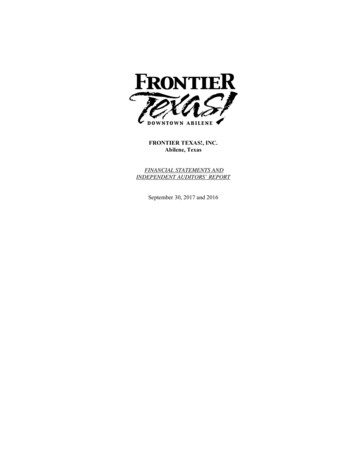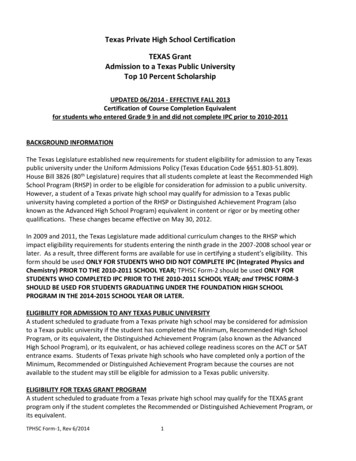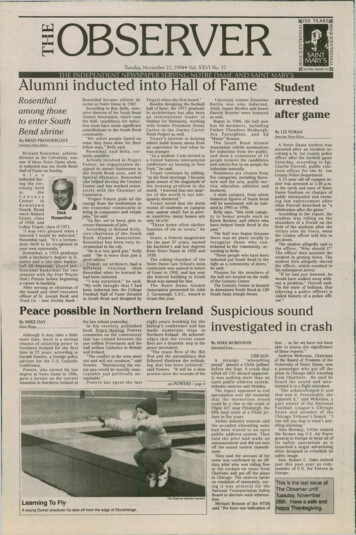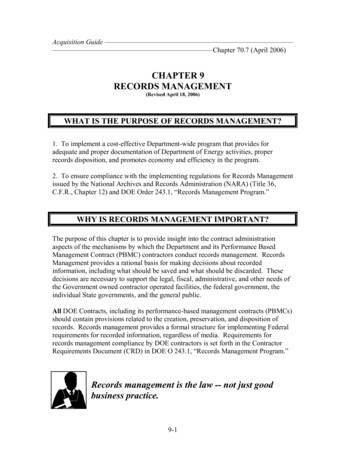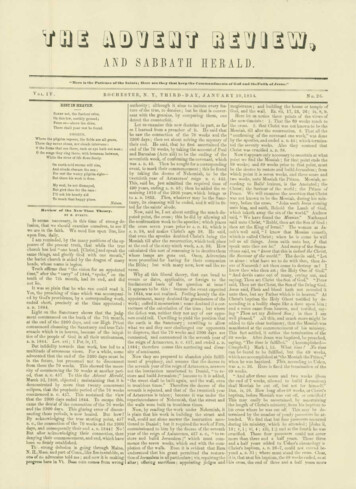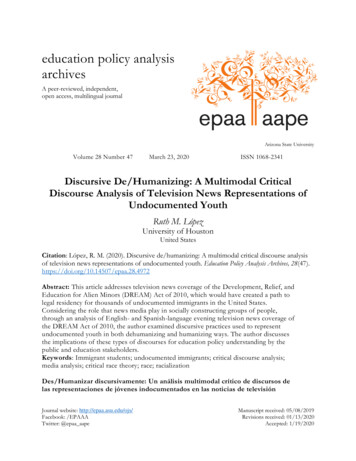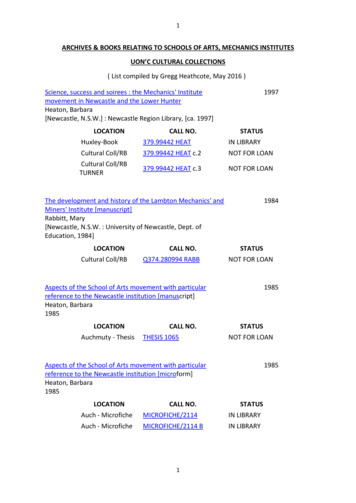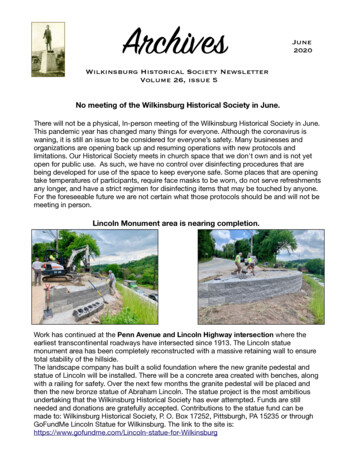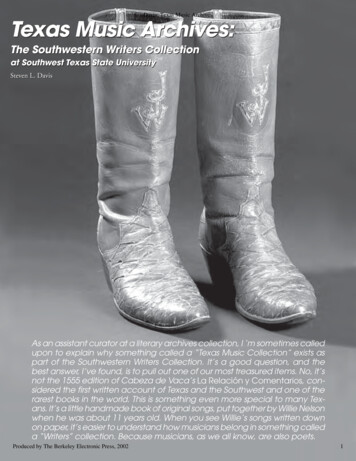
Transcription
Davis: Texas Music Archivesat Southwest Texas State UniversitySteven L. Davisat Southwest Texas State UniversityThe Southwestern Writers CollectionTexas Music Archives:The Southwestern Writers CollectionTexas Music Archives:Lizard skin boots made by Charlie Dunn for Jerry Jeff Walker, with Walker’s initials. Jerry Jeff Walker papers. Photo by Brianne Corn, courtesy SWWC. 31As an assistant curator at a literary archives collection, I ’m sometimes calledupon to explain why something called a “Texas Music Collection” exists aspart of the Southwestern Writers Collection. It’s a good question, and thebest answer, I’ve found, is to pull out one of our most treasured items. No, it’snot the 1555 edition of Cabeza de Vaca’s La Relación y Comentarios, considered the first written account of Texas and the Southwest and one of therarest books in the world. This is something even more special to many Texans. It’s a little handmade book of original songs, put together by Willie Nelsonwhen he was about 11 years old. When you see Willie’s songs written downon paper, it’s easier to understand how musicians belong in something calleda “Writers” collection. Because musicians, as we all know, are also poets.Produced by The Berkeley Electronic Press, 20021
Journal of Texas Music History, Vol. 2 [2002], Iss. 1, Art. 4at Southwest Texas State UniversityTexas Music Archives:The Southwestern Writers Collection 32Willie Nelson songbook, written at age 10-11. Front cover, Table of Contents, and “Starting Tonight” song lyric. Willie Nelson papers. Photo by BrianneCorn, courtesy SWWC.Willie’s songbook is just one item in an extensive collectionon the legendary star; also included are pages of handwrittensong lyrics, concert programs and posters, tour itineraries, photographs, and publicity clippings. One can find several files onNelson’s “Farm Aid” initiative in the 1980s: correspondence,annual reports, newsletters from grassroots farm organizations,publications from various state departments of agriculture, concert memorabilia, grant proposals, and applications for funding. The Nelson papers contain material on one of the singer’sbleakest periods—his trouble with the Internal Revenue Service in the 1980s and 1990s. The archives contain a notice ofseizure from the IRS, as well as government documents andinventories for the 1991 auction of Willie’s property. The Nelsonpapers are rounded out by a staple of any archival collection,representative artifacts, such as Willie’s bandanas, sunglasses, t–shirts, and even a pair of his well–used running shoes, completewith mismatched shoelaces.Another good question that people often ask is “How do youget all this stuff?” In the case of Willie Nelson, as well as most ofour other archival collections, the answer is very simple. Thematerials are graciously donated by benefactors who wish to seethat the collections are preserved and made available for researchers. The Willie Nelson collection came through the efforts of our founding donors, Bill and Sally Wittliff, along withWillie himself, Bud Shrake, and Jody Fischer.Courtesy Arhoolie Records2
Davis: Texas Music ArchivesPhoto courtesy SWWC.at Southwest Texas State UniversityPhotoof BobBerkeleyWills, TexasWestern SwingHall2002of Fame collection.Producedby TheElectronicPress,Texas Music Archives:The Southwestern Writers CollectionThe Willie Nelson collection will prove to be a valuable treasure trove of detailed information for future historians. The touritineraries, for example, detail where Willie and his band wereon specific dates. The snatches of song lyrics captured on hotelstationary trace the development of some of Willie’s best–knownhits, along with a few songs that never got off the ground. Thecorrespondence from fans offers first–hand testimony about howthe singer affected numerous lives; some even make the case forWillie as a secular saint. The “Farm Aid” files illuminate theinner workings of an organization that reflects Nelson’s sense ofsocial obligation to his fans.The Southwestern Writers Collection, founded in 1986, isone of the youngest of the major archival repositories in thestate. We consider ourselves a “living collection” in many ways.Not only are many of our donors and artists still living, we alsocontinue to grow steadily as we collect and preserve the worksof significant Texas and Southwest writers, musicians, and filmmakers. We are committed to collecting Texas music materialsthat represent the state’s rich diversity, from country and Western Swing to blues, polka, rock and roll, conjunto and Tejano.To that end, we’ve gathered hundreds of representative recordings from performers in all genres. In terms of our primary sourcematerials, the archives,what we collect depends on what peopleCourtesy Arhoolie Recordschoose to donate. We’ve had tremendous success so far, partlybecause of our responsible stewardship and good word–of–mouth reputation. The first thing we do after taking in acollection is basic preservation work—rehousing all material in acid–free folders and boxes and storing them in aclimate–controlled facility. Though every archives collection has a large backlog of uncataloged material, we havemade it an institutional priority to expeditiously “process” the collections—which means that the materials areorganized and a detailed inventory and guide to the collection is compiled. We place all of our “finding aids,” asthese guides are called, on our worldwide web site.The Internet revolutionized academic research, and institutions that make finding aid information available viathe Web are a welcome sight to scholars. A researcher canquickly locate archival collections and review online whatspecific material is available for research. The Web hascertainly brought widespread attention to our own musicholdings, as well as our other archival collections. Thenumerous inquiries we receive from researchers all overthe world are good indicators of the widespread interestin Texas music history.Our Texas Music Collection includes a number ofprominent Texas musicians and musical styles. We arehonored to be the archival repository for the Texas Western Swing Hall of Fame, which has been led for severalyears by Al Dressen. Among the holdings are rare treasures from the King of Western Swing, Bob Wills. Thecollection contains Wills’s blazer, along with a hat he wore 333
Journal of Texas Music History, Vol. 2 [2002], Iss. 1, Art. 4at Southwest Texas State UniversityTexas Music Archives:The Southwestern Writers CollectionCourtesy Arhoolie Records 34and a fiddle he played. Additional artifacts are stage outfits wornby the Light Crust Doughboys, along with Laura Lee McBride’sfringed leather costume. The collection is rounded out by numerous sound recordings, rare photographs, awards, clippings,posters, momentos, and other items that pay homage to Western Swing legends such as Milton Brown, Smokey Montgomery, Cliff Bruner, Tommy Duncan, Johnny Gimble, Hank Thompson, Leon “Pappy” Selph and many others.Country music is represented by our holdings on WillieNelson as well as contributions from Jerry Jeff Walker, whoplayed at the dedication of the Southwestern Writers Collection. Walker has donated a pair of his Charlie Dunn boots, aswell as his handwritten lyrics for his song honoring the reveredbootmaker. Long–time Austin City Limits producer Bill Arhoshas recently donated numerous personal archives from histwenty–odd years of guiding the celebrated television show.Arhos’s materials are like having a backstage pass to Austin CityLimits, and they include candid photographs, rare ephemera,concert posters, program schedules, press packets, newsclippings,correspondence, sound recordings, and magazines.Another very exciting area of the Texas Music Collection isthe material relating to conjunto and Tejano music. Included inthe collection are copies of some 12,000 recordings made byMexican–American performers in Texas and the Southwest fromthe 1920s to the 1980s. As any student of Texas history knows,there remains a wide disparity between Anglo and Mexican interpretations of specific historical events. Too often, historiansin the past have relied solely on written Anglo accounts. TheMexican view was often overlooked or ignored, many ecause no published work on particular historical events existed. Yet as Américo Paredes so vividly demonstrates in hisgroundbreaking book, With His Pistol in His Hand: A BorderBallad and Its Hero, a vital response to Anglo history can oftenbe found in the music, particularly the corridos, popular amongMexican communities. In that sense, these 12,000 songs offerimmense potential for future researchers interested in Mexicanperspectives. Much of the story of the Mexican presence in Texasremains to be told, and some of it will undoubtedly appear infuture research into collections such as this.Another important collection of note is the Selena: Como laflor archives, donated by Texas Monthly Senior Editor Joe NickPatoski, who wrote an acclaimed biography of the murderedTejano superstar. The archive consists of early drafts of the book,extensive research into Selena’s life, interviews with dozens ofmusicians and others who knew Selena, correspondence, hundreds of Selena–related clippings and other publications, documents from the Yolanda Saldívar trial, and an extensive recordof Patoski’s relationship with his publisher. The collection isuseful to researchers in many ways, from a possible examination of how the Anglo media portrayed Selena, to her relationships with others in the Tejano music industry. Among the mostfascinating aspects of the collection are the oral interviews. Onlya very small portion of the interviews ended up in the pages ofPatoski’s narrative, yet a wealth of information was collected.For example, one of Patoski’s interviewees was Laura Canales, apioneering female singer in the male–dominated world of Tejanomusic. Patoski and Canales discuss Selena in their conversation, yet they also speak at great length about the issues womenface in the music industry. That subject goes beyond the scopeCourtesy Arhoolie Records4
Davis: Texas Music Archivesat Southwest Texas State UniversityTexas Music Archives:The Southwestern Writers Collection 35Bob Wills and his Texas Playboys, Showboat Hotel, Las Vegas, March 13–June 7, 1959. Texas Western Swing Hall of Fame collection. Photo courtesy SWWC.of Patoski’s biography and is waiting to be ferreted out by enterprising researchers. Patoski’s extensive interviews function verymuch as a collective oral history of Texas’s Tejano music scene.Stevie Ray Vaughan is the subject of another major researchcollection donated by Joe Nick Patoski and Bill Crawford, coauthors of Stevie Ray Vaughan: Caught in the Crossfire. The collection has received intense attention from several researchers,but much more remains to be analyzed. Patoski and Crawfordassembled a wealth of research material for their biography, andthe collection contains dozens of bootleg recordings spanningthe entire breadth of Vaughan’s career, from his early days withProduced by The Berkeley Electronic Press, 2002the Cobras in 1975 to his final performance in Wisconsin onAugust 26, 1990. As in the Selena papers, the rich oral interviews with numerous musical personalities are of particular interest. Included here are discussions with B.B. King, Ray Benson,W.C. Clark, Kim Wilson, Buddy Guy, Angela Strehli, and Austin club owner Clifford Antone. The conversations not onlyilluminate Stevie Ray Vaughan’s personality and musicianship;they also document the rise of Austin’s music scene in the 1970sand 1980s.Patoski has written for Texas Monthly for some 25 years now,and he has also donated his personal writing archives to the5
Journal of Texas Music History, Vol. 2 [2002], Iss. 1, Art. 4at Southwest Texas State UniversityTexas Music Archives:The Southwestern Writers CollectionSouthwestern Writers Collection. At Texas Monthly, Patoski hascovered a wide variety of stories, from bargain–hunting excursions along the Texas–Mexico border, to meditative explorationsof the rugged reaches of Texas’s mountain country. But for muchof his tenure at Texas Monthly, Patoski has been the magazine’sprincipal music writer. As such, he has received hundreds ofpromotional materials over the years, such as press kits and soundrecordings covering everything from hillbilly punk to gospel rap.Patoski also served for a time as the manager for Joe “King”Carrasco and the Crowns, a popular Texas party band thatblended Tex–Mex with New Wave. Material from his time withCarrasco is also present in the collection, including Joe King’sroyal cape and crown.Texas Monthly magazine is one of the signature archival collections held at SWT. In 1994 the magazine agreed to donateits enormous archives to the Southwestern Writers Collection,and the materials fill an entire warehouse annex. Texas Monthlyhas covered Texas music extensively over the years, and its archives offer additional opportunities to music researchers.Thanks to a grant from the Texas State Libraries and ArchivesCommission in 1999, we have completed the massive task ofprocessing the first five years of the magazine’s editorial archives:1973–78. Through internal memos, correspondence, notes fromeditorial meetings, responses from readers, and other files, researchers can piece together the ways in which the state’s leading mainstream publication reported on the state’s music.Another Texas Monthly writer, Mike Hall, was once known asthe leader of an Austin–based band, The Wild Seeds. Since joining Texas Monthly’s staff, Hall has written stories on personalities ranging from Lance Armstrong to Roky Erickson. In thespring of 2000, Hall conducted interviews with several musicians for a feature story on a curious phenomenon: why so manygreat musicians hail from Lubbock. Hall envisioned the story asan oral h
Willie Nelson songbook, written at age 10-11. Front cover, Table of Contents, and “Starting Tonight” song lyric. Willie Nelson papers. Photo by Brianne . Corn, courtesy SWWC. Willie’s songbook is just one item in an extensive collection on the legendary star; also included are pages of handwritten song lyrics, concert programs and posters, tour itineraries, pho -tographs, and publicity .


